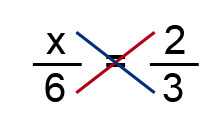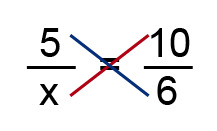11. Proportions
Proportions
Proportions can be also be used to compare quantities in different units. For example, if [[$ 3 $]] kg of strawberries costs € [[$ 5 \: $]], then [[$ 15 $]] kg of same strawberries will cost € [[$ 25 \: $]]. The ratio between the quantity and price of strawberries therefore remains the same.
[[$ \displaystyle\frac {3 \: \text {kg}} {5 \: \text {€}} = \displaystyle\frac {15 \: \text {kg}} {25 \: \text {€}} $]]
The proportion to be divided in proportional distribution is divided as indicated by the ratio.
In proportions, colons are often used to signify division. The quantities of proportions are named as follows:

A special feature of proportion equations is that the product of its furthest quantities is equal to the product of its middle quantities. This can be achieved with a process called cross multiplying, as seen below:

If three quantities of a proportion equation are known, the fourth unknown can solved with cross multiplication. After this, the equation can be solved according to the familiar equation-solving rules.
Example 1
Solve the proportions.
a) [[$ \displaystyle\frac {x} {6} = \displaystyle\frac {2} {3} $]]
b) [[$ \displaystyle\frac {5} {x} = \displaystyle\frac {10}{6} $]]
Solution:
| a) |  |
Cross-multiplication is applied. |
| [[$ \quad \begin{align} 3x &= 6 · 2 \ \\ 3x &= 12 \space ||:3 \ \\ x &= 4 \end{align} $]] |
| b) |  |
Cross-multiplication is applied. |
| [[$ \quad \begin{align} 5 · 6 &= 10x \ \\ 30 &= 10x \ \\ -10x &= -30 \space ||:(-10) \ \\ x &= 3 \end{align} $]] |
Example 2
Divide € [[$ 32 $]] in a ratio of [[$ 3 : 5 $]] using a proportion equation.
[[$ \quad \begin{align} \dfrac{x}{32 - x} &= \dfrac{3}{5} \ \\
5x &= 3(32 - x) \ \\
5x &= 96 - 3x \ \\
5x + 3x &= 96 \ \\
8x &= 96 \space ||:8 \ \\
x &= \dfrac{96}{8}
x &= 3 \end{align} $]]
The first part is [[$ 12 $]], whereas the other part is [[$ 32 –12 = 20 $]].
Answer: The parts are [[$ 12 \: \text € $]] and [[$ 20 \: \text € $]].
